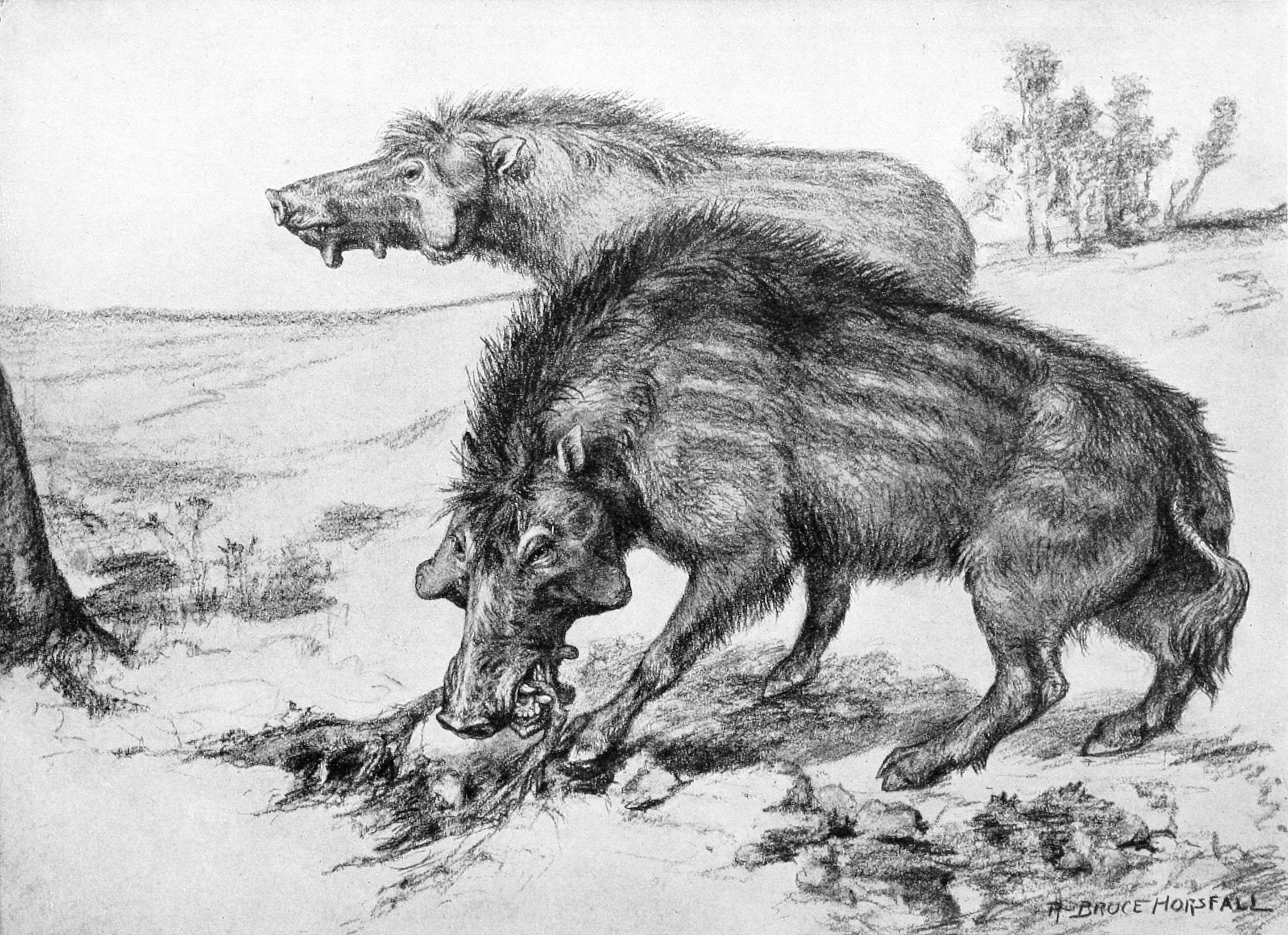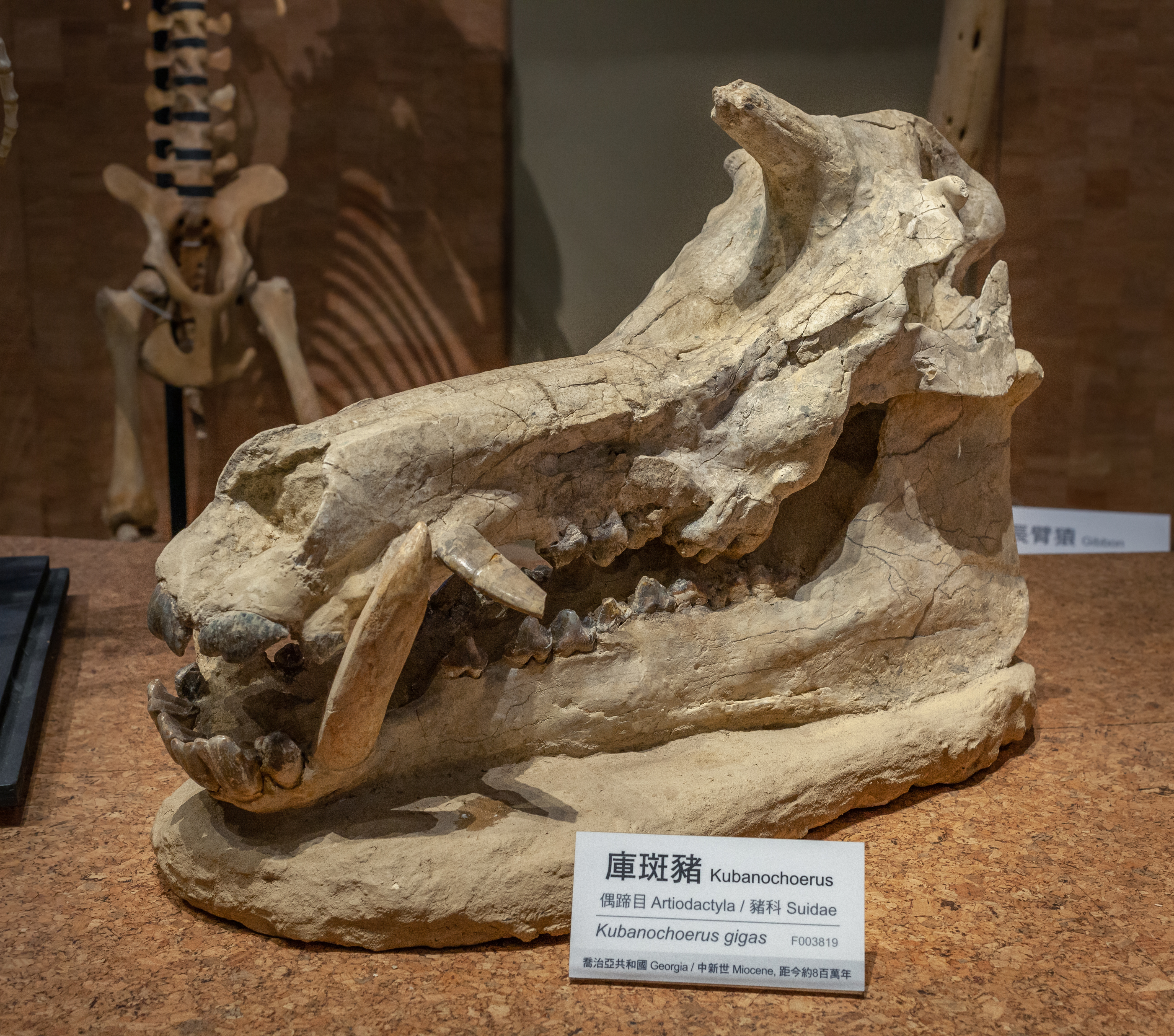|
Entelodont
Entelodontidae is an extinct family of pig-like artiodactyls (even-toed ungulates) which inhabited the Northern Hemisphere (Asia, Europe, and North America) from the late Eocene to the early Miocene epochs, about 38-19 million years ago. Their large heads, low snouts, narrow gait, and proposed omnivorous diet inspires comparisons to suids (true pigs) and tayassuids (peccaries), and historically they have been considered closely related to these families purely on a morphological basis. However, studies which combine morphological and molecular (genetic) data on artiodactyls instead suggest that entelodonts are cetancodontamorphs, more closely related to hippos and cetaceans through their resemblance to ''Pakicetus'', than to basal pigs like '' Kubanochoerus'' and other ungulates. Description Entelodonts could get quite large, and in many cases are the largest mammals in their respective ecosystems. The largest entelodont known from a complete skeleton was '' Daeodon'', a No ... [...More Info...] [...Related Items...] OR: [Wikipedia] [Google] [Baidu] |
Archaeotherium Mortoni 01
''Archaeotherium'' (, meaning "ancient beast") is an extinct genus of entelodont Even-toed ungulate, artiodactyl endemic to North America during the Eocene and Oligocene epochs (35–28 Year, mya). ''Archaeotherium'' fossils are most common in the White River Formation of the Great Plains, but they have also been found in the John Day Fossil Beds National Monument, John Day Basin of Oregon and the Trans-Pecos area of Texas. ''Archaeotherium'''s fossils come from North America, between the Priabonian and Rupelian stages of the Eocene and Oligocene (35–28 million years ago). Up to fifteen species of ''Archaeotherium'' have been identified, which are divided into three Subgenus, subgenera. One contains the type species, ''A. mortoni'', among others; another contains very large taxa formerly named ''Megachoerus'' and ''Pelonax''; and the last contains ''A. calkinsi''. ''Archaeotherium'' was distinguished from most entelodonts by having an unusually long snout and large Jugal bone, ... [...More Info...] [...Related Items...] OR: [Wikipedia] [Google] [Baidu] |
Daeodon
''Daeodon'' is an extinct genus of entelodont even-toed ungulates that inhabited North America about 29 to 15.97 million years ago from the early Oligocene to late early Miocene. The type species is ''Daeodon shoshonensis'', described from a very fragmentary holotype by Cope. Some authors synonymize it with ''Dinohyus hollandi'' and several other species (see below), but due to the lack of diagnostic material, this may be questionable. Another large member of this family, possibly larger than ''Daeodon'', is the Asian ''Paraentelodon,'' but it is known by very incomplete material. Taxonomy The genus ''Daeodon'' was erected by the American anatomist and paleontologist Edward Drinker Cope in 1878. He classified it as a perissodactyl and thought that it was closely related to ''Menodus''. This classification persisted until the description of ''"Entelodon, Elotherium" calkinsi'' in 1905, a very similar and much more complete animal from the same rocks, which was promptly assign ... [...More Info...] [...Related Items...] OR: [Wikipedia] [Google] [Baidu] |
Entelodon
''Entelodon'' (meaning 'complete teeth', from Ancient Greek ''entelēs'' 'complete' and ''odōn'' 'tooth', referring to its "complete" eutherian dentition), formerly called ''Elotherium'', is an extinct genus of entelodont artiodactyl endemic to Eurasia. Fossils of species are found in Paleogene strata ranging in age from the Houldjinian (37.2–33.9 mya) until the Rupelian epoch of the early Oligocene (33.9–28.4 mya). Taxonomy It is one of four entelodont genera native to Eurasia, the other three being the primitive '' Eoentelodon'' of late Eocene China, '' Proentelodon'' of middle Eocene Mongolia and the gigantic ''Paraentelodon'' of mid-to-late Oligocene The Oligocene ( ) is a geologic epoch (geology), epoch of the Paleogene Geologic time scale, Period that extends from about 33.9 million to 23 million years before the present ( to ). As with other older geologic periods, the rock beds that defin ... Central Asia. Description ''Entelodon'' was a fairly typical ent ... [...More Info...] [...Related Items...] OR: [Wikipedia] [Google] [Baidu] |
Paraentelodon
''Paraentelodon'' is an extinct entelodont from the Late Oligocene of Asia. The fossils of the type species ''P. intermedium'' were found in Georgia, Kazakhstan and China. An indeterminate species represents in Bugti Hills which is the late Oligocene of Pakistan.G. Métais, P.-O. Antoine, L. Marivaux, J.-L. Welcomme, and S. Ducrocq. 2003New artiodactyl ruminant mammal from the late Oligocene of Pakistan Acta Palaeontologica Polonica 48(3):375-382 Discovery and naming ''Paraentelodon'' was named by L. K. Gabunia in 1964 basing on molars and canine teeth that were found in Oligocene sites of Benara, Georgia (Georgian SSR at the time of discovery). It was assigned to Entelodontidae by Carroll (1988). In 1996 Lucas and Emry found ''Neoentelodon'' to be synonymous with ''Paraentelodon''. Although Gabunia did not explain the etymology, the name ''Paraentelodon'' is derived from the Greek ''para''/παρα "beside" or "near", ἐντελής entelēs "complete" or "perfect" and ... [...More Info...] [...Related Items...] OR: [Wikipedia] [Google] [Baidu] |
Early Miocene
The Early Miocene (also known as Lower Miocene) is a sub-epoch of the Miocene epoch (geology), Epoch made up of two faunal stage, stages: the Aquitanian age, Aquitanian and Burdigalian stages. The sub-epoch lasted from 23.03 ± 0.05 annum, Ma to 15.97 ± 0.05 Ma (million years ago). It was preceded by the Oligocene epoch. As the climate started to get cooler, the landscape started to change. New mammals evolved to replace the extinct animals of the Oligocene epoch. The first members of the hyena and weasel family started to evolve to replace the extinct ''Hyaenodon'', entelodonts and bear-dogs. The chalicotheres survived the Oligocene epoch. A new genus of entelodont called ''Daeodon'' evolved in order to adapt to the new habitats and hunt the new prey animals of the Early Miocene epoch; it quickly became the top predator of North America. But it became extinct due to competition from ''Amphicyon'', a newcomer from Eurasia. ''Amphicyon'' bested ''Daeodon'' because the bear-dog's la ... [...More Info...] [...Related Items...] OR: [Wikipedia] [Google] [Baidu] |
Cetancodontamorpha
Cetancodontamorpha is a total clade of artiodactyls defined, according to Spaulding ''et al''., as Whippomorpha "plus all extinct taxa more closely related to extant members of Whippomorpha than to any other living species". Whippomorpha is the crown clade containing Cetacea (whales, dolphins, etc.) and hippopotamuses. Members of the whippomorph stem group (i.e., "stem-whippomorphs") include such taxa as the family Entelodontidae and the genus ''Andrewsarchus ''Andrewsarchus'' (), meaning "Roy Chapman Andrews, Andrews' ruler", is an extinct genus of artiodactyl that lived during the Eocene, Middle Eocene in what is now China. The genus was species description, first described by Henry Fairfield Osb ...''. References Cetruminantia Phylogenetics Taxa described in 2009 {{eventoedungulate-stub ... [...More Info...] [...Related Items...] OR: [Wikipedia] [Google] [Baidu] |
Miocene
The Miocene ( ) is the first epoch (geology), geological epoch of the Neogene Period and extends from about (Ma). The Miocene was named by Scottish geologist Charles Lyell; the name comes from the Greek words (', "less") and (', "new") and means "less recent" because it has 18% fewer modern marine invertebrates than the Pliocene has. The Miocene followed the Oligocene and preceded the Pliocene. As Earth went from the Oligocene through the Miocene and into the Pliocene, the climate slowly cooled towards a series of ice ages. The Miocene boundaries are not marked by distinct global events but by regionally defined transitions from the warmer Oligocene to the cooler Pliocene Epoch. During the Early Miocene, Afro-Arabia collided with Eurasia, severing the connection between the Mediterranean and Indian Oceans, and allowing the interchange of fauna between Eurasia and Africa, including the dispersal of proboscideans and Ape, hominoids into Eurasia. During the late Miocene, the conn ... [...More Info...] [...Related Items...] OR: [Wikipedia] [Google] [Baidu] |
Ungulate
Ungulates ( ) are members of the diverse clade Euungulata ("true ungulates"), which primarily consists of large mammals with Hoof, hooves. Once part of the clade "Ungulata" along with the clade Paenungulata, "Ungulata" has since been determined to be a polyphyletic and thereby invalid clade based on molecular data. As a result, true ungulates had since been reclassified to the newer clade Euungulata in 2001 within the clade Laurasiatheria while Paenungulata has been reclassified to a distant clade Afrotheria. Living ungulates are divided into two orders: Perissodactyla including Equidae, equines, rhinoceroses, and tapirs; and Artiodactyla including Bos, cattle, antelope, Sus (genus), pigs, giraffes, camels, Ovis, sheep, deer, and Hippopotamidae, hippopotamuses, among others. Cetaceans such as Whale, whales, Dolphin, dolphins, and Porpoise, porpoises are also classified as artiodactyls, although they do not have hooves. Most terrestrial ungulates use the hoofed tips of their toes ... [...More Info...] [...Related Items...] OR: [Wikipedia] [Google] [Baidu] |
Artiodactyls
Artiodactyls are placental mammals belonging to the order Artiodactyla ( , ). Typically, they are ungulates which bear weight equally on two (an even number) of their five toes (the third and fourth, often in the form of a hoof). The other three toes are either present, absent, vestigial, or pointing posteriorly. By contrast, most perissodactyls bear weight on an odd number of the five toes. Another difference between the two orders is that many artiodactyls (except for Suina) digest plant cellulose in one or more stomach chambers rather than in their intestine (as perissodactyls do). Molecular biology, along with new fossil discoveries, has found that cetaceans (whales, dolphins, and porpoises) fall within this taxonomic branch, being most closely related to hippopotamuses. Some modern taxonomists thus apply the name Cetartiodactyla () to this group, while others opt to include cetaceans within the existing name of Artiodactyla. Some researchers use "even-toed ungulates" to excl ... [...More Info...] [...Related Items...] OR: [Wikipedia] [Google] [Baidu] |
Molecular Genetics
Molecular genetics is a branch of biology that addresses how differences in the structures or expression of DNA molecules manifests as variation among organisms. Molecular genetics often applies an "investigative approach" to determine the structure and/or function of genes in an organism's genome using genetic screens. The field of study is based on the merging of several sub-fields in biology: classical Mendelian inheritance, cellular biology, molecular biology, biochemistry, and biotechnology. It integrates these disciplines to explore things like genetic inheritance, gene regulation and expression, and the molecular mechanism behind various life processes. A key goal of molecular genetics is to identify and study genetic mutations. Researchers search for mutations in a gene or induce mutations in a gene to link a gene sequence to a specific phenotype. Therefore molecular genetics is a powerful methodology for linking mutations to genetic conditions that may aid th ... [...More Info...] [...Related Items...] OR: [Wikipedia] [Google] [Baidu] |
Kubanochoerus
''Kubanochoerus'' is an extinct genus of large, long-legged suidae, suid artiodactyl mammal from the Miocene of Eurasia and Africa. Taxonomy The genera ''Libycochoerus'' and ''Megalochoerus'' were once assigned to ''Kubanochoerus'' but are now considered distinct based on dental and minor cranial details. The putative paraceratheriid genus ''Caucasotherium'', described from the Caucasus on the basis of a bone fragment with four incisors, is actually a synonym of the Middle Miocene ''Kubanochoerus gigas''. Description The largest species, the aptly named ''K. gigas'', grew to be around at the shoulder, and probably weighed up to in life. tesorosnaturales.es The heads of these pigs were unmistakable, with small eyebro ... [...More Info...] [...Related Items...] OR: [Wikipedia] [Google] [Baidu] |
Hyotheriinae
Hyotheriinae was a subfamily of even-toed ungulates that existed during the Miocene and Pliocene in Europe, Asia, and Africa. Genera *†'' Aureliachoerus'' Ginsburg, 1974 - Miocene, Europe *†'' Chicochoerus'' Orliac et al., 2006 - Miocene, Europe *†'' Chleuastochoerus'' Pearson, 1928 - Miocene and Pliocene, Asia *†'' Hyotherium'' von Meyer, 1834 - Miocene, Europe and Asia *†'' Nguruwe'' Pickford, 1986 - (previously located in the subfamily of Kubanochoerinae) Miocene, Africa *†'' Xenohyus'' Ginsburg, 1980 - Miocene, Europe Europe is a continent located entirely in the Northern Hemisphere and mostly in the Eastern Hemisphere. It is bordered by the Arctic Ocean to the north, the Atlantic Ocean to the west, the Mediterranean Sea to the south, and Asia to the east ... References Prehistoric Suidae Mammal subfamilies {{paleo-eventoedungulate-stub ... [...More Info...] [...Related Items...] OR: [Wikipedia] [Google] [Baidu] |








